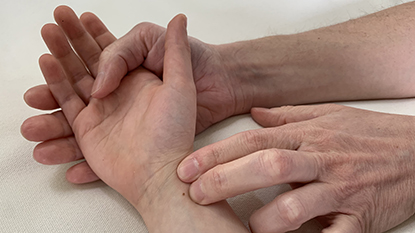How to Take Your Child's Pulse
What Is Your Pulse?
A person's pulse, or heart rate, is the number of times the heart beats per minute. It will change depending on things like activity, stress, body temperature, medicines, and illness.
How Do I Take My Child's Pulse?
You will need a stopwatch or a watch with a minute hand. Have your child relax without running, jumping, crying, etc., for at least 5 minutes.
Taking an Infant's Pulse
The best spot to feel the pulse in an infant is the upper am, called the brachial pulse. Lay your baby down on the back with one arm bent so the hand is up by the ear. Feel for the pulse on the inner arm between the shoulder and the elbow:
- Gently press two fingers (don't use your thumb) on the spot until you feel a beat.
- When you feel the pulse, count the beats for 15 seconds.
- Multiply the number of beats you counted by 4 to get the beats per minute.

Taking a Child's Pulse
The best spot to feel the pulse in a child is the wrist, called the radial pulse. Gently feel on the inside of the wrist on the thumb side.

If you can't easily find the pulse on the wrist, you can try the neck, which has the carotid pulse. Gently place your fingers on one side of the windpipe:
- Gently press two fingers (don't use your thumb) on the spot until you feel a beat.
- When you feel the pulse, count the beats for 15 seconds.
- Multiply the number of beats you counted by 4 to get the beats per minute.

What's a Normal Heart Rate?
A normal heart rate is based on a child's age. Infants have different normal heart rates from teens. Kids' heart rates can be lower when resting or asleep and higher when they're very active.
Check with your doctor to see what range is considered normal for your child.
When Should I Take My Child's Pulse?
Usually, there's no need to take your child's pulse. Your doctor will check it during office visits.
Sometimes, though, a parent may need to take a pulse. You might do this if your child has:
- a medical condition that requires you to monitor their heart rate. Your doctor will let you know if you need to do this, and if you should do it regularly or only on occasion. If you're not sure, ask your doctor.
- a skipping, pounding, or racing heart
- chest pain
- dizziness
- a fainting spell
- fast breathing
Call your doctor to review your child's symptoms and share the pulse you counted.
Go to the ER or call 911 right away if your child has any of the symptoms listed above and:
- is hard to wake up
- has trouble breathing. Look for muscles pulling in between the ribs or the nose puffing out with each breath.
- has pale or grey skin, or blue lips
The 911 operator may ask you to take your child's pulse and count the heart rate.
What Else Should I Know?
Some smartphone apps can count a pulse by pressing a finger over the camera lens. For a good reading, your child needs to be very still, so this method works best in older kids who can cooperate. Some fitness and other smart watches can take a pulse too. Before using one of these, ask your doctor if it's a good idea or if they recommend a particular heart rate app.


